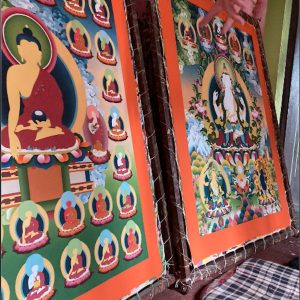
My Summer doing Buddhist Art in Nepal
Immersing in Thangka Painting and More
Our alumna Nahelia Aguila Castillo (MA ‘21) shared her unforgettable journey of discovering the ancient art of Thangka painting in Nepal in the summer of 2022. And discover through her eyes the beauty and sacredness of art, friendship, and nature in the holy land of Nepal.
What is Thangka Painting, and why did you choose to go to Nepal to learn it?
“A Thangka is a sacred art that can be rolled up. Thangkas were commissioned for many purposes—as aids to meditation, as requests for long life, as tokens of thanksgiving for having recovered from illness, or in order to accumulate merit. Usually subjects depicted in thangkas are peaceful deities, wrathful deities, and mandalas. Each Tibetan Buddhist sect has its favorite gods; therefore, identifying a particular god depicted on a thangka helps determine the sect with which the painting is associated.” (https://education.asianart.org/resources/tibetan-thangka-painting-sacred-pictures )
Somehow the universe gave me the opportunity to go to Nepal. I was in the right place at a very random moment. Walking through the university one afternoon, I ran into Doug Powers. He was holding a tube in his hand. When he saw me he said, Hey, do you want to see something cool? Since I have a very curious nature I said, Yes. He opened it and took out what I thought was a print of a Buddhist image. I said, Wow, this print is very neat. He quickly corrected me, saying, It’s not a print, it’s a painting. Surprised, I brought my face closer to the piece of art to see if I could distinguish the brush strokes. It was really hard to believe what he was saying. Nevertheless, there they were! So fine, and the colors were blended so perfectly. It’s amazing! I said. This is an old Tibetan art, he said, and you can go to Nepal and learn if you want to. He only needed to say that. For me, even though I had very little experience painting and I was not very sure what a Thangka was, the idea of going to the other side of the world to paint a Buddha felt sacred. I remember having said, Yes, let’s do it. Everything is history from there.
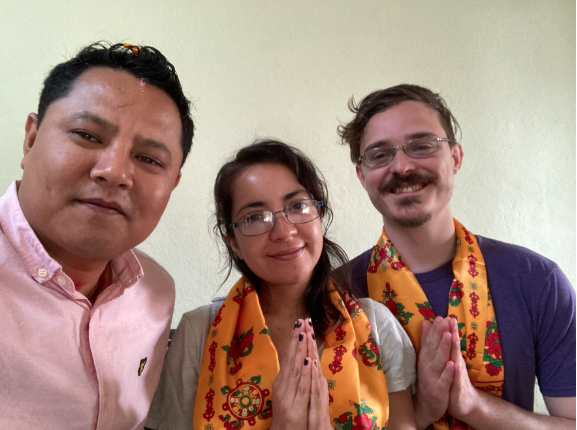
When I arrived in Nepal with a friend from DRBU, we contacted Gyanesh, Doug’s friend, the person whose family owns the Thangka workshop. He was not going to be in Nepal for another few weeks, so he asked his brother to contact us and take us to the workshop. Tara is his brother’s name. I have to say, he was a very kind soul covered by a serious personality (at first glance). He took us around and also took us to his relatives’ places to meet them. We shared meals and stories. Apparently this family has been making Thangkas for some generations. Their main workshop is in Kathmandu, but there are also family members who live in their hometown where they also paint. One very interesting thing I learned was that the family has painting techniques that are unique to them.
What was the highlight of your experience there?
It was a complete adventure from top to bottom. There are many things that I loved and enjoyed and now I treasure (even the ones that at the moment were challenging). It is really hard to pick one. When we arrived, the feeling of surprise, excitement, and awe wrapped my heart. I was on the other side of the planet, in the old world. Everything felt like a different universe, and yet there were so many similarities to Mexico. The greatest surprise was that Nepali people are the kindest and warmest I have ever met. They are very welcoming and will do anything for their guests to feel comfortable. Such beautiful people.
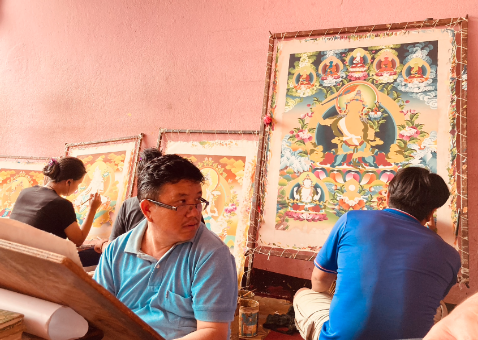
One highlight was definitely the idea of learning the idea of something ancient and precious like this. It was very exciting. And it felt a little bit mythical. In many ways, it really was. I liked waking up in the mornings and walking between the old streets close to the famous Patan Durbar Square. Most days for breakfast, I would buy some oatmeal cookies and sometimes grab a coffee. Then I would walk for fifteen minutes to get to the art workshop. All I could think of was to do my best in the painting. I realized that they weren’t used to receiving random people to teach them, yet they gave me a chance. I felt very honored, and I just really didn’t want them to feel that they were wasting their time with me.
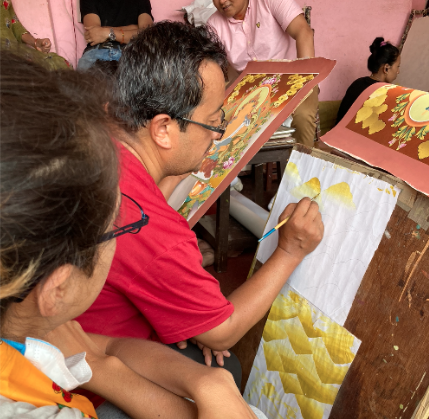
I mainly had two teachers. The first one was Maila Tamang, one of the more knowledgeable teachers in the workshop. He was very kind to me. He was always smiling and from time to time would throw a joke in Nepali that I couldn’t understand. I would laugh with him anyways. Even though our communication was very limited, he taught me with great patience and sincerity. He would make me watch him and then make some signs so that I should try to copy what he was doing. He would mainly tell me one of these three things: Good, very good, and not good, do again. I have to say, it would make my day everytime he said the first two. The second one wasn’t very common; thus, it was like blue diamonds for me.
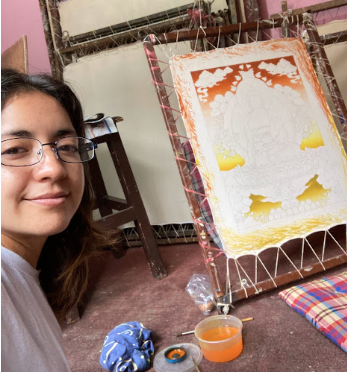
My afternoon teacher was Puja. She was a very beautiful and young Nepali woman who agreed to spend some of her work time teaching me. She was direct and honest but also very kind. She wouldn’t hesitate to tell me,You should repeat that. I feel a lot of gratitude for both of them.
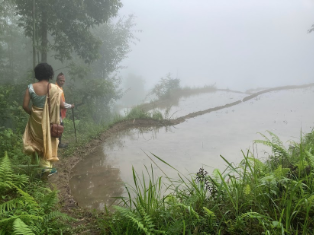
Share with us one memorable thing you did there!
I think my favorite memory among all was to go to the rice field with our friend Sanju and her family on her birthday. I think it was the very first time I felt the power of nature. It’s very difficult to explain, but I guess it was because we were very far away from everything really. It was powerful and beautiful.

Finally what was your take away from this abroad experience for your life?
That Nepali people are amazing. Also, no matter how far we are from each other, we all smile, get curious, suffer, and are afraid. We are all humans. We are all beautiful beings trying to do our best. And that there is so much beauty in the world, internally and externally.
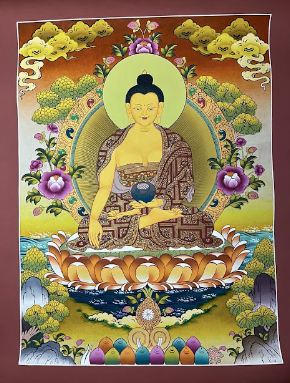 This is the final painting. It was finished in collaboration with the great teachers. I couldn’t finish it myself due to sickness and lack of time. Nevertheless, I learned a lot in this incredible experience. Interesting fact: The golden lines are painted with real gold. This is a technique that serious painters use because otherwise the golden color would fade overtime.
This is the final painting. It was finished in collaboration with the great teachers. I couldn’t finish it myself due to sickness and lack of time. Nevertheless, I learned a lot in this incredible experience. Interesting fact: The golden lines are painted with real gold. This is a technique that serious painters use because otherwise the golden color would fade overtime.